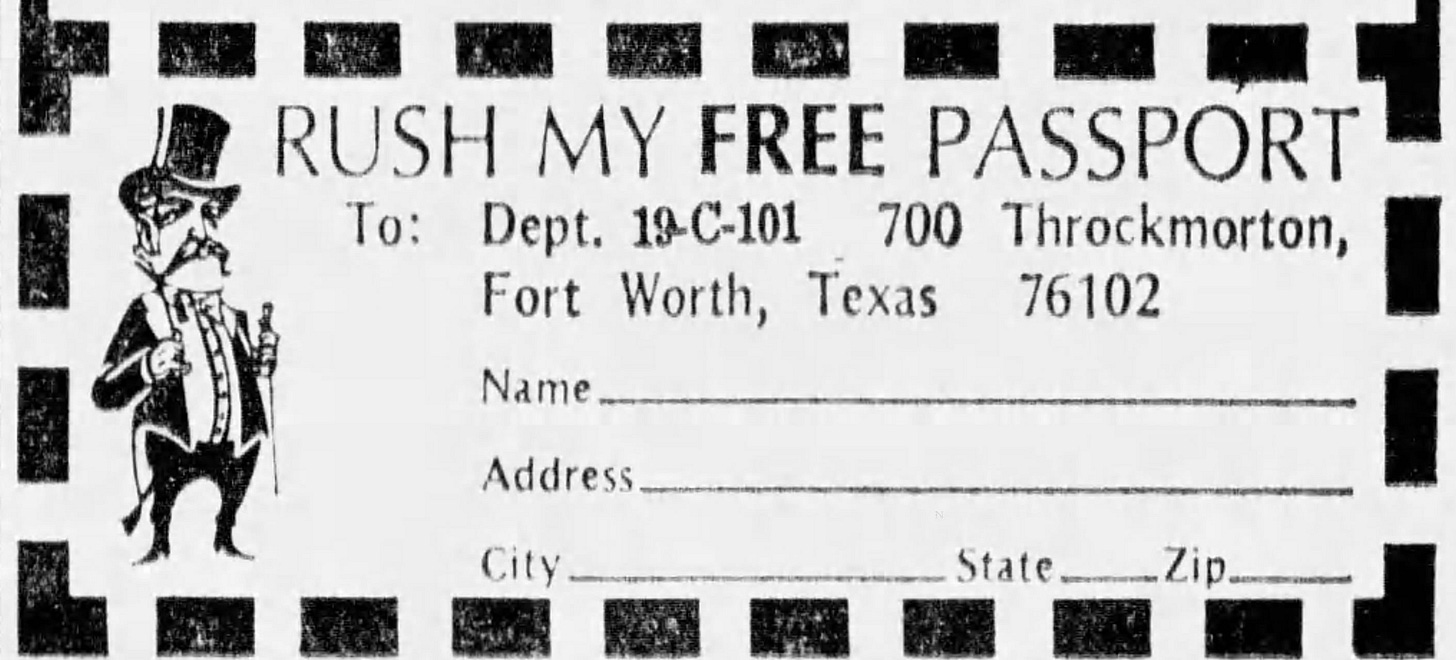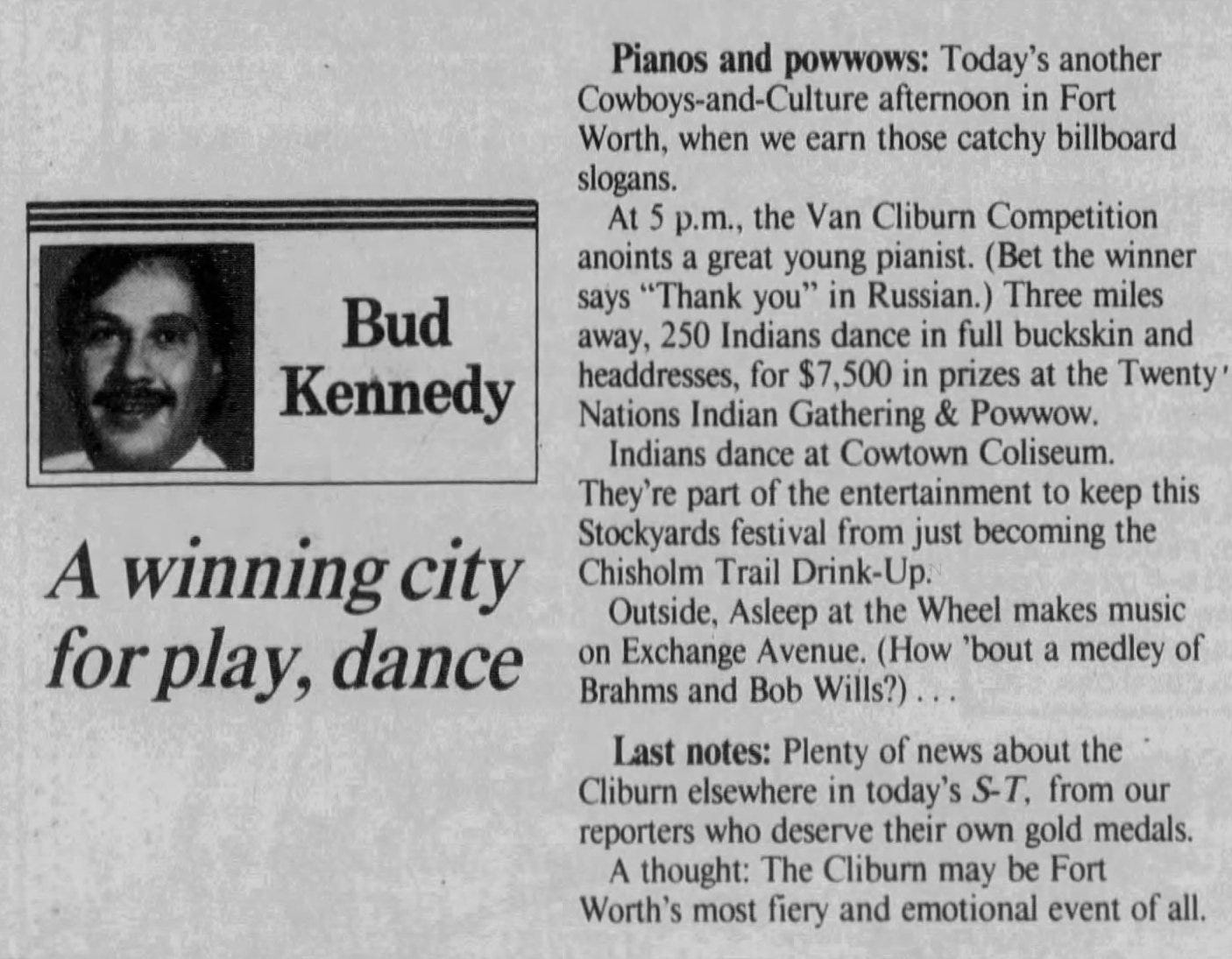A short history of Fort Worth's split personality
"Cowboys and Culture" has always been a dubious marketing slogan.
In 1990, a writer for Texas Monthly called Fort Worth “one schizophrenic city.” In context, the moniker is not quite mocking; the article is a straightforward travel story, a guide for prospective tourists on where to stay, what to eat, and how to entertain themselves. Fort Worth’s alleged schizophrenia stemmed from the contradictory menu of options available to visitors, a split symbolized by the Stockyards and the Cultural District:
Fort Worth is one schizophrenic city. It is best known as Cowtown, the cradle of Western Swing, Where the West Begins. Backing up that rough-and-tumble image is the Stockyards National Historic District, the North Side’s collection of cowboy bars, Western stores, and steak-’n’-potatoes restaurants. But perhaps in reaction to that sprawling personality, another Fort Worth has emerged, one that is uncommonly concerned with appearances and high culture. The cluster of museums and civic amenities called the Cultural District is the pride of the moneyed West Side.
The city’s bifurcated sense of self was, according to the Monthly, a boon to the out-of-towner, giving them a chance to revel in fantasies of “the West” and artistic “high culture” in a single afternoon. While local officials gushed over the free marketing, with one telling the Fort Worth Star-Telegram it was equal to an entire year’s worth of promotional costs, they didn’t rush to claim “One Schizophrenic City" as a new slogan. (Weird, right?)
Instead, the city’s tourism bureau was busy hustling a new marketing brochure, which tried to reconcile Fort Worth’s competing identities by way of a more anodyne catchphrase: “Cowboys and Culture.” As anyone who has spent five minutes in the city knows, the slogan persists (though not without criticism,1 and there are signs Fort Worth may be lurching slowly away from the tired cliche2). But this glossy pamphlet from the summer of 1990, which advised visitors to explore “the Western Heritage Trail” and “the Museum and Garden Tour,” was not the first instance of “Cowboys and Culture” in city marketing materials — not even close.
To find the origins of the phrase, you have to go further back in history. The first documented use of “Cowboys and Culture”3 appears in a 1974 advertising campaign, apparently orchestrated by the then-Tarrant County Convention and Visitors Bureau. That summer, ads in newspapers across Texas offered a free “passport to fun in astonishing Fort Worth,” seemingly a coupon book for use at local restaurants and hotels. The campaign targeted residents of El Paso, Lubbock, Corpus Christi and other cities, but also reached beyond Texas, beckoning to residents of Kansas City, Wichita, Shreveport, and Oklahoma City. It promised “family fun at the crossroads of cowboys and culture,” and most versions featured little cartoon men, one in a tuxedo and the other in a stetson, whom I’ve nicknamed Mr. Culture and Mr. Cowboy respectively.
Tourism officials aren’t the only ones who’ve pushed the “Cowboys and Culture” narrative. In 1984, the Fort Worth Chamber of Commerce hosted an “Evening of Cowboys and Culture” at Sundance Square, where artistic posters emblazoned with the slogan were handed out. Meanwhile, Star-Telegram writers have used and remixed the phrase many times over the years, sometimes with a hint of ironic distance, but usually in reference to the opening of some new fine arts colossus (for example: the Bass Performance Hall) or to promote local events (like when the annual Chisholm Trail Round-Up at the Stockyards overlapped with the Van Cliburn piano competition). The ugliest and most unnecessary example is a weird spinoff, “pianos and powwows.” It appeared once in a 1989 column by Bud Kennedy and never, as far as I can tell, resurfaced.
To me, all this suggests “Cowboys and Culture” is primarily a long-running scheme dreamed up by public relations executives to separate tourists from their money. This isn’t the same as saying the slogan has no basis in reality or that it hasn’t had an impact on how residents see the city; fifty years of flogging the same simple idea will inevitably shape people’s perceptions of their home. But it can hardly be called an organic expression of Fort Worth’s true identity, whatever that might be.
Perhaps the most revealing example of this is the 1977 short film “Fort Worth: The Unexpected City,” which was funded by the First National Bank of Forth Worth and released to celebrate the bank’s 100-year anniversary. (The bank itself no longer exists, having been gobbled up by the chain of mergers and acquisitions that ultimately gave birth to the modern-day Bank of America.)
What exactly is “unexpected” about Fort Worth, according to First National Bank? Well, the film’s narrator, Hollywood superstar and stalwart everyman Jimmy Stewart,4 emphasizes the “unexpected sophistication of this town perched on the edge of the prairie.” Stewart tells us: “I don’t know of another town — and I’ve seen quite a few — where you could enjoy great art on one side of the street and take in a cattle auction on the other.”
In other words: Cowboys and Culture.
The 16-minute film is such a striking snapshot of the “schizophrenic city” coming into being. It reflects clear insecurities among the people who donated to Fort Worth art museums and bought season tickets to the Fort Worth Opera, an uneasy sense among affluent types that the refined cosmopolitan elites of New York and London were snickering at them. “Fort Worth? You mean that place where they trade cows?” In the film, local philanthropist and First National Bank executive Alann Sampson dispenses cheery ripostes to this perceived condescension:
The first thing they ask is “How many horses do you have?” and “Where are your oil wells?” and “I don’t see you toting your gun,” and when you ask them if they’ve ever heard of the Kimbell Art Museum or Louis Kahn, they say, “Surely,” and we say, “Do you realize that one of his largest monuments to his genius is in Fort Worth?” “Oh yes, you really do have the Kimbell!” Or we ask them if they realize that the Van Cliburn competition is here. “Oh, I didn’t really realize, yes!”
The director of “Fort Worth: The Unexpected City” told the Star-Telegram in 2017 that, when the film was being made, the city “was sweeping the ‘Cowtown’ image under the carpet, and I thought that was what was really wonderful about the city.” Yet the film is not some revanchist counterstroke against the advance of museum culture. Even people who clung to imagery of the “Old West” and wanted to see it preserved must have realized their society was shifting. By the late 1970s, the Fort Worth Stockyards was no longer a vital economic engine, the big local meatpacking plants having shuttered years before. Rather than a bold argument in favor of a revitalized agricultural sector, the film is an attempt to produce a new, marketable Fort Worth through the soothing alchemy of Jimmy Stewart’s iconic stammer. The new direction had potential economic upsides that were more glamorous and less, well, industrial.
The film was described by the bank as “a gift to the people of Fort Worth” and is viewed now as a “love letter” to the city, but newspaper reports at the time suggest other motives. It “would be useful for the travel industry and for corporations seeking to hire executives or other employees from out of state,” according to an executive of the public relations firm behind the film who spoke to the Star-Telegram in 1977. From this perspective, “Fort Worth: The Unexpected City” was an ingenious marketing ploy, not only for First National Bank but for Fort Worth’s business sector as a whole. It was a more high-brow version of 1974’s “passport to fun” that realized — consciously or not — that Fort Worth’s traditional livestock roots would be more useful if reimagined as a tourist attraction or as “heritage” to validate the expectations of middle-class emigrants from other states.
If one is going to call Fort Worth a schizophrenic city, it makes more sense to highlight the following delusion: That a city’s personality can be distilled into an alliterative slogan without losing something vital.
While this is a small detail, it’s fascinating to me that the little cartoon men on the 1974 “passport to fun” ads are identical to each other, save for their outfits. The implications are ambiguous and open to interpretation: Does this suggest that, despite the apparent differences between the Stockyards and the Cultural District, the two are somehow essentially the same? Does it mean Fort Worth’s cowboys feel equally at home in the rodeo arena and the Botanic Gardens? Or does it indicate that the modern “cowboy” is a superficial aesthetic easily adopted by the otherwise-dignified Mr. Culture when it suits him?
Call me pessimistic, but I’m inclined toward the latter view. The catchphrase “Cowboys and Culture” only works if the idea of a “cowboy” confirms the prior expectations of people who’ve never lived in the Lone Star State. It must be a costume, recognizable to eyes trained by Hollywood sets.5 To the point: A 1988 Star-Telegram profile of Fort Worth’s tourism bureau observed that “publications touting the city picture cowboys on horseback and label Fort Worth ‘The Way You Want Texas To Be.’” This is, ironically, the opposite of Fort Worth as “the Unexpected City.”
So what about the people who actually live here? What do they want “the Texasmost city,” as Texas Monthly put it, to look like? Also, what is actually unexpected about Fort Worth? What are the stories that aren’t dreamed up by rich people who want to feel less insecure? What doesn’t get mentioned in the city’s attempt to market itself as a hot tourist destination? Where is the People’s History of Fort Worth?
As Jimmy Stewart asks in the opening of the First National Bank film:
What caused a city to grow up on this particular piece of ground, anyhow? What made it take root and grow when lots of the others just sort of died out?
Obviously, I don’t think the answer is anything resembling “Cowboys and Culture.” But unwinding the obvious and manufactured mythos of the city, while finding genuine answers to those questions, is one goal of this newsletter.
P.S. Here’s the film itself, if you’re interested:
For example, a survey of Fort Worth’s “young professionals” conducted in the early 2010s by the Chamber of Commerce and TCU’s business school discovered that the kids didn’t like how “every marketing thing put out by any major city organization is cowboys and culture.” Too cringe!
The city’s latest attempt to reinvent itself as a shiny hub for innovation and tech start-ups does not fit smoothly with longhorn branding and old artwork. According to a 2019 report on small businesses and entrepreneurship in the city: “Fort Worth’s traditional brand is ‘Cowboys and Culture’. This message is attractive to many audiences, but it does not necessarily portray Fort Worth as place where innovation happens.” But not to worry: The city may yet preserve its brand heritage with a pivot to the truly horrifying “cowboys and culture and crypto.”
Or as far as I can tell, based on searches through the Star-Telegram’s archives.
In a way, Jimmy Stewart is a perfect narrator for this film precisely because of his contradictory position in American pop culture. How can someone be one of the most famous actors of his generation and still symbolize a relatable, “aw shucks” everyman? If anyone could unify the seemingly disparate halves of Fort Worth’s civic brand, it was him.
This is not to say that “authentic” cowboys never existed or don’t still exist. But relying on popular frontier iconography for tourism purposes creates a strong incentive to shape the remnants of cowboy culture in Fort Worth into something that goes down as easily as a classic Western on AMC.









